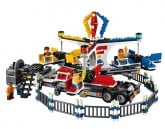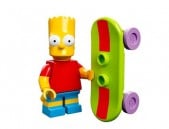Latest Gear Live Videos
Monday May 23, 2005 10:20 pm
E3 Interview: Mark Rosewater - Head Designer of Magic: The Gathering
 Last week at E3 we had the opportunity to sit down and chat with Magic: The Gathering designers Mark Rosewater, Randy Buehler and Magic pro player Sam Gomersa. Magic the Gathering is the first collectible card game and is set in a fantasy setting. It has been going strong now for 12 years with no end in sight. Magic: The Gathering can also be played via Magic: The Gathering: Online. The latest version of Magic Online version 3.0 should be out in stores shortly.
Last week at E3 we had the opportunity to sit down and chat with Magic: The Gathering designers Mark Rosewater, Randy Buehler and Magic pro player Sam Gomersa. Magic the Gathering is the first collectible card game and is set in a fantasy setting. It has been going strong now for 12 years with no end in sight. Magic: The Gathering can also be played via Magic: The Gathering: Online. The latest version of Magic Online version 3.0 should be out in stores shortly.Most of our readers may not have heard of Mark Rosewater or Randy Buehler, who are the designers of Magic. These men are two of the greatest game designers on this earth. Their work is enjoyed by millions of gamers across the globe and their design has kept one of the most successful and longest running games going strong today. Join as they both give us a rare chance to see the secrets to the successful design of Magic: The Gathering, including video games, here today with Mark Rosewater, Wednesday with Randy Buehler and Friday with Magic Pro Player Sam Gomersa:
In a short explanation what is Magic the Gathering?
Magic the Gathering is a collectible card game. The best analogy is it's like playing Monopoly without all the pieces.
And what is Magic the Gathering Online?
A transliteration of the game. The idea for it came about from the main reason players quit, they did not have enough people to play with and had a hard time finding a game. Magic Online solved this problem, players can now find a game 24 hours, 7 days a week.
What makes Magic so popular?
Several reasons:
First it’s highly customizable. That is because Magic the Gathering supports a lot of styles of gaming and fantasy.
Second Magic is the crispy hash browns. Everyone knows the best part of the hash browns is the top part, the crispy hash browns and the bottom part is not as good. The best part of a game is when you first get it and you are figuring out the strategies, the crispy hash brown. After you figure out all the strategies the game turns into the bottom of the hash brown. Since Magic changes cards every few months this changes the strategy, which allows magic to grow back the crispy hash brown.
Third Magic has a lot of ego investment. Playing the game requires a lot of time spent in preparing, by creating decks and practicing with the decks. When you win your deck wins, validating all your work. Games like Poker is just about the cards your dealt and does not validate your efforts.
What role do you play in designing Magic the Gathering?
Head Magic Designer, I am in charge of the design, which is the creative elements of the game. That is the art, names, flavor. In other words I give magic its soul. Better way put it, I do all the cool things and fellow developer Brian Schneider makes sure the ideas work and do not break the game.
What is all the different ways (formats) that magic can be played?
Many ways. The most common ways is Constructed and limited. Constructed is where you play with a deck you created. Limited is played in two forms: sealed or draft. In sealed you create a deck with the cards you are handed. In draft it is like when you where in the school yard and picking teams, you picked the best players for your team. Draft is the same, you are handed a group of cards and pick the best card amongst the cards.
Did R&D invent all the formats?
No
How do you think Magic Online has effected the table top version of the game?
Not very much other than the fact that players can now find a game 24 hours 7 days a week.
How has Magic Online effected they way you are designing cards and sets?
Not much, just in a few subtle ways.
How do you come up with a theme for each set?
A bunch of ways. We have a theme every year for each new set. Right now there is three major themes. With Ravnica, the first set with me doing the vision, it going be the fourth new theme that will very different then anything before. It will challenge everything you know about a set.
When you are designing a set who do you design for?
A variety of players. We design mostly for the 3 major types of players that play Magic.
Which are?
The Spike, which is the competitive player to whom winning is everything.
The Johnny, to whom Magic is used to prove he his creative. Winning is not as important to him and when he wins he likes to win with style.
The Timmy, who just wants to have fun. To him Magic is more social and winning in not important as long as he is having a good time and fun with his fellow players.
Which one are you?
I am a Johnny with some Timmy, more Johnny than anything else though.
What is the hardest group to design for?
Hardest thing is having enough stuff for everyone. Vintage is challenge to no upset the format. Causal players are also tough. The hardest has to be to pull off a hat trick, which is a card that all three groups like. This is rare and happens only once or twice a set.
What is the easiest?
Spike, they will play anything that is good.
With the growing card pool in Magic the Gathering how do you plan to deal with power creep that will
create only one deck that players in formats like Vintage will be able to play?
We do recognize this will be a problem in the future for Vintage. The number one tool to solve this problem is not there yet. We are not ready yet to ban cards in Vintage and going in to the future we are very hesitant to ban cards. R&D has had discussions about this issue and we have possible solutions, but in the short time this not an issue. This will be an issue in long term and I can not stress it enough, R&D is working hard towards solving this issue. Vintage needs to stop panicking like Chicken Little, the sky is not falling down. For Legacy this not an issue, we can ban cards. While we do not plan to reprint dual lands, since they upset other formats, we do plan to print very good dual land like lands that will make Legacy players happy.
How do you come up with ideas for card?
Old cards, at random, all sorts of ways.
What are all the steps in creating a card?
Lots of ways, there is never one clear step.
How do you balance everything so everyone is happy or sometimes do you design cards that will upset some of
the groups and different formats?
You can not make cards that everyone is happy about. We educate people that some cards are not for you. The #1 lesson take from this is not every card is designed for you. If you do not like a card it most likely not made for you.
How did you come up with the color Pie chart?
The color pie chart gives each color its flavor and mechanisms. I did not invent it, Richard Garfield did. However I am big subscriber to the color pie. I feel it ‘s the backbone of the game.
How did you decided what ability, mechanic and creature type each color got?
Set philosophy dictated by each colors flavor.
I recently heard you readjusted the number of cards per each set how did this effect your design decisions
for each set and did it create balance issue in certain formats like limited?
It had a small impact in the short term. In long term it did not seem to impact design.
Is there stead fast rules when you design a card for each color or will you sometimes break the rules for
example give it something on color pie chart it should never have?
As a general rule of thumb we don’t bleed the color pie chart. From time to time we do if the card adds something neat to the game.
When designing cards do you attempt to fix past issues caused by previous cards?
We occasionally do fix cards. Meaning we make a card that was to go in the past and make it weaker. Or we make a card that was weak in the past and make it stronger. When we do this, we try to make the version we think that is the more balanced version whatever direction that may be.
Do you add sometimes problem cards in some formats like “Ume ZawaB Jitte” and “Skullclamp” or are those
pure accidents?
We never purposely unbalance a format. Any card we end up banning, obvious we would not done it if we could go back in time. It is not our goal to make things that upset the game.
Do you personally regret creating a card?
Yes there where cards that where mistakes. I try not to make the same mistake again. I get really mad at myself when ever I do make a card that makes the same mistake. We have a bad habit with two things that tend to bite us. They are cards that let you draw too many cards and cards that let you play cards without paying their costs. The things I regret is things which I kinda know better, but still do. By and large I do not regret my cards - they are what they are.
What is your favorite card?
My favorite card is Maro because it named after me.
Favorite creature type?
I am a big fan of the squirrel. I like a lot of creature types. I like goblins. I like zombies, I am a big zombie fan. I kinda of enjoy mixing up the creature types. l also like dwarfs.
Do you plan to ever explore some of the less used creature types like Elephants and Dwarfs ?
We try to mix in different creatures. Some years we use ones that are used all the time. Some years we use lesser ones. From year to year you will see that creature type varies.
What about less used abilities like banding and rampage?
Some abilities we use we like and we bring them back. Some we do think are useful and we do not bring them back. I consider mechanics like tools in that during Champions of Kamigawa we where making the set we had a mechanic that worked like indestructible. Instead of coming up with a new mechanic we said what the heck it’s indestructible, even though it’s from two set earlier. It’s kinda of a new philosophy in the last two years.
Do you plan to ever design a video game?
Who knows, right now I am happy designing magic. It’s my dream job and I am enjoying it. Never say never. I do believe there is a lot of crossover between game design, traditional games and computer games. I believe computer game players are game players. I believe they play for the same reason regardless what they are playing and I think if you understand gamers and now how to make them happy you can apply that to anything.
I write a column about game design. In the column I am talking about making magic but I have a lot of people who do make computer games who say they have a lot use for the stuff I write, even though I am not writing about computer games. I think it boils down to gamer are gamers, they play for the same reasons, whether they are playing Doom or playing magic or playing whatever. The reasons they like playing are the same they are universal. I think a lot of game design boils down to it is making something that makes your audience happy about and enjoying the game experience. Its true different game have different tools, Computer games have different tools available to them and there is a different experience in playing a computer game but I do believe that you are trying to do the same thing I am trying. Which is make your end customer happy. If you make them happy they buy your games, they will keep buying your games, they will suggest them to their friends. IF you make a game that makes them feel happy you will make a lot of money.
Any last comments?
I do think it important for the computer game designers to look at the non-computer games and realize that really games are games, that even though they get separated by categories and by where they are sold, when push comes to shove games are game. If you want to make a good computer game you have to have the principles of a good non-computer game. The most common mistake made by computer game makers is doing all the cool stuff you can do on computers and just missing the fact that if it’s not a good it just does not matter. Yes it can be the fanciest, coolest looking thing in the world but if there is not game play, if there is not something that makes the experience fun, I do not care its not going to be a good game. People do not buy games because they are pretty, they buy games because they are fun. It’s nice that they look pretty, I am not saying they shouldn’t look pretty, clearly consumers are coming to expect a certain level of graphics and such. Do not fall on the common mistake which is made all the time with computer games. Make good graphics and they will flock to you, they will look at you, they will pay attention, but if its not fun to play they are not going to keep playing and they are not keep buying
your product and it’s not going be a big success. Computer game designers really have to realize when that push comes to shove you have to make an entertaining fun game. I think that gets missed a lot of times because of other factors which they are paying attention, which are important, you need them but if it is not fun then I do not care. If the game isn’t fun, this true in non-computer games, if my game is not fun people aren’t going to buy my game, that why people play. Gamers play it because its enjoyable because its something they want to do and you have to make the experience fun for them. Games are a hobby for a lot of people, it’s a big way they spend their time, if you do not make something that enhances their lifestyle or enhances their hobby, they will move on to the guy who does. This does not matter whether it’s a computer game or not.
Playfeed thanks Mark Rosewater for taking the time to talk with us. Join us Wednesday for part two of the E3 Interviews with Magic the Gathering staff as we talk with Randy Buehler.
- Related Tags:
Advertisement
Advertisement
Advertisement
© Gear Live Media, LLC. 2007 – User-posted content, unless source is quoted, is licensed under a Creative Commons Public Domain License. Gear Live graphics, logos, designs, page headers, button icons, videos, articles, blogs, forums, scripts and other service names are the trademarks of Gear Live Inc.











Comments: